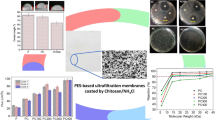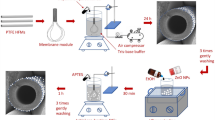Abstract
A commercially available nanofiltration membrane, NF90, was modified using an in situ concentration polarization-enhanced radical graft polymerization method to improve the organic fouling resistance as well as the removal of pharmaceutical and personal care products (PPCPs), including ibuprofen (IBU), carbamazepine, sulfadiazine, sulfamethoxazole, sulfamethazine, and triclosan (TRI). 3-Sulfopropyl methacrylate potassium salt (SPM) and 2-hydroxyethyl methacrylate (HEMA) were used in various dosages for surface modification, and the extent of membrane modifications was quantified based on the degree of grafting. The modified NF90 exhibited a 15–40% lower flux during humic acid (HA) fouling and 25% greater NaCl rejection compared with the virgin membrane. PPCP rejection in the modified NF90 membranes before and after HA fouling was 20–45% and 5–20% greater, respectively, compared with that of the virgin membrane. Both SPM and HEMA increased the hydrophilicity of NF90 by decreasing contact angles. Scanning electron microscopy revealed lower amounts of foulants on the modified NF90 than on the virgin membrane. The main fouling mechanism for virgin NF90 was gel layer formation and those for modified NF90 were complete and intermediate blocking. Therefore, the modification of NF90 was effective for controlling organic fouling and strongly rejecting PPCPs.









Similar content being viewed by others
References
Anderson PD, D’Aco VJ, Shanahan P, Chapra SC, Buzby ME, Cunningham VL, DuPlessie BM, Hayes EP, Mastrocco FJ, Parke NJ, Rader JC, Samuelian JH, Schwab BW (2004) Screening analysis of human pharmaceutical compounds in U.S. surface waters. Environ Sci Technol 38:838–849
Arsuaga JM, López-Muñoz MJ, Sotto A (2010) Correlation between retention and adsorption of phenolic compounds in nanofiltration membranes. Desalination 250:829–832
Belfer S, Bottino A, Capannelli G (2005) Preparation and characterization of layered membranes constructed by sequential redox-initiated grafting onto polyacrylonitrile ultrafiltration membranes. J Appl Polym Sci 98:509–520
Ben-David A, Bernstein R, Oren Y, Belfer S, Dosoretz C, Freger V (2010) Facile surface modification of nanofiltration membranes to target the removal of endocrine-disrupting compounds. J Membr Sci 357:152–159
Bolong N, Ismail AF, Salim MR, Matsuura T (2009) A review of the effects of emerging contaminants in wastewater and options for their removal. Desalination 239:229–246
Enick OV, Moore MM (2007) Assessing the assessments: pharmaceuticals in the environment. Environ Impact Assess Rev 27:707–729
Fair PA, Lee HB, Adams J, Darling C, Pacepavicius G, Alaee M, Bossart GD, Henry N, Muir D (2009) Occurrence of triclosan in plasma of wild Atlantic bottlenose dolphins (Tursiops truncatus) and in their environment. Environ Pollut 157:2248–2254
Giri RR, Ozaki H, Ota S, Takanami R, Taniguchi S (2010) Degradation of common pharmaceuticals and personal care products in mixed solutions by advanced oxidation techniques. Int J Environ Sci Technol 7:251–260
Gol RM, Jewrajka SK (2014) Facile in situ PEGylation of polyamide thin film composite membranes for improving fouling resistance. J Membr Sci 455:271–282
Herklotz PA, Gurung P, Vanden Heuvel B, Kinney CA (2010) Uptake of human pharmaceuticals by plants grown under hydroponic conditions. Chemosphere 78:1416–1421
Homem V, Santos L (2011) Degradation and removal methods of antibiotics from aqueous matrices--a review. J Environ Manag 92:2304–2347
Jin X, Hu J, Ong SL (2007) Influence of dissolved organic matter on estrone removal by NF membranes and the role of their structures. Water Res 41:3077–3088
Kim I, Tanaka H (2009) Photodegradation characteristics of PPCPs in water with UV treatment. Environ Int 35:793–802
Kim JH, Park PK, Lee CH, Kwon HH (2008) Surface modification of nanofiltration membranes to improve the removal of organic micro-pollutants (EDCs and PhACs) in drinking water treatment: graft polymerization and cross-linking followed by functional group substitution. J Membr Sci 321:190–198
Kimura K, Iwase T, Kita S, Watanabe Y (2009) Influence of residual organic macromolecules produced in biological wastewater treatment processes on removal of pharmaceuticals by NF/RO membranes. Water Res 43:3751–3758
Kinney CA, Furlong ET, Zaugg SD, Burkhardt MR, Werner SL, Cahill JD, Jorgensen GR (2006) Survey of organic wastewater contaminants in biosolids destined for land application. Environ Sci Technol 40:7207–7215
Klavarioti M, Mantzavinos D, Kassinos D (2009) Removal of residual pharmaceuticals from aqueous systems by advanced oxidation processes. Environ Int 35:402–417
Kochkodan V, Hilal N (2015) A comprehensive review on surface modified polymer membranes for biofouling mitigation. Desalination 356:187–207
Kostich MS, Batt AL, Lazorchak JM (2014) Concentrations of prioritized pharmaceuticals in effluents from 50 large wastewater treatment plants in the US and implications for risk estimation. Environ Pollut 184:354–359
Lee J, Chae HR, Won YJ, Lee K, Lee CH, Lee HH, Kim IC, Lee JM (2013) Graphene oxide nanoplatelets composite membrane with hydrophilic and antifouling properties for wastewater treatment. J Membr Sci 448:223–230
Lin YL (2013) Effects of physicochemical properties of nanofiltration membranes on the rejection of small organic DBP precursors. J Environ Eng 139:127–136
Lin YL (2018) In situ concentration-polarization-enhanced radical graft polymerization of NF270 for mitigating silica fouling and improving pharmaceutical and personal care product rejection. J Membr Sci 552:387–395
Lin YL, Lee CH (2014) Elucidating the rejection mechanisms of PPCPs by nanofiltration and reverse osmosis membranes. Ind Eng Chem Res 53:6798–6806
Lin YL, Chiang PC, Chang EE (2006) Reduction of disinfection by-products precursors by nanofiltration process. J Hazard Mater 137:324–331
Lin YL, Chiang PC, Chang EE (2007) Removal of small trihalomethane precursors from aqueous solution by nanofiltration. J Hazard Mater 146:20–29
Lin JCT, Cheng AC, Lin YF, Lee DJ, Guo WM (2012) Dense membranes precoated with aluminium tridecamer (Al13) for water treatment. Desalination 284:349–352
Lin YL, Chiou JH, Lee CH (2014) Effect of silica fouling on the removal of pharmaceuticals and personal care products by nanofiltration and reverse osmosis membranes. J Hazard Mater 277:102–109
Michael I, Rizzo L, McArdell CS, Manaia CM, Merlin C, Schwartz T, Dagot C, Fatta-Kassinos D (2013) Urban wastewater treatment plants as hotspots for the release of antibiotics in the environment: a review. Water Res 47:957–995
Mohammad AW, Teow YH, Ang WL, Chung YT, Oatley-Radcliffe DL, Hilal N (2015) Nanofiltration membranes review: recent advances and future prospects. Desalination 356:226–254
Mukherji ST, Leisen J, Hughes JB (2011) Removal and biosorption of C(6)(0) from water by an aquatic plant, Ceratophyllum sp. Chemosphere 84:390–396
Nghiem LD, Coleman PJ (2008) NF/RO filtration of the hydrophobic ionogenic compound triclosan: transport mechanisms and the influence of membrane fouling. Sep Purif Technol 62:709–716
Orvos DR, Versteeg DJ, Inauen J, Capdevielle M, Rothenstein A, Cunningham V (2002) Aquatic toxicity of triclosan. Environ Toxicicol Chem 21:1338–1349
Radjenovic J, Petrovic M, Ventura F, Barcelo D (2008) Rejection of pharmaceuticals in nanofiltration and reverse osmosis membrane drinking water treatment. Water Res 42:3601–3610
Rodayan A, Roy R, Yargeau V (2010) Oxidation products of sulfamethoxazole in ozonated secondary effluent. J Hazard Mater 177:237–243
Saeki D, Tanimoto T, Matsuyama H (2014) Anti-biofouling of polyamide reverse osmosis membranes using phosphorylcholine polymer grafted by surface-initiated atom transfer radical polymerization. Desalination 350:21–27
Safarpour M, Khataee A, Vatanpour V (2015) Thin film nanocomposite reverse osmosis membrane modified by reduced graphene oxide/TiO2 with improved desalination performance. J Membr Sci 489:43–54
Schwartz T, Kohnen W, Jansen B, Obst U (2003) Detection of antibiotic-resistant bacteria and their resistance genes in wastewater, surface water, and drinking water biofilms. FEMS Microbiol Ecol 43:325–335
Tomer N, Mondal S, Wandera D, Wickramasinghe SR, Husson SM (2009) Modification of nanofiltration membranes by surface-initiated atom transfer radical polymerization for produced water filtration. Sep Sci Technol 44:3346–3368
Ulbricht M, Belfort G (1996) Surface modification of ultrafiltration membranes by low temperature plasma II. Graft polymerization onto polyacrylonitrile and polysulfone. J Membr Sci 111:193–215
Vela MCV, Blanco SAB, García JL, Rodríguez EB (2009) Analysis of membrane pore blocking models adapted to crossflow ultrafiltration in the ultrafiltration of PEG. Chem Eng J 149:232–241
Wilke CR, Chang P (1955) Correlation of diffusion coefficients in dilute solutions. AICHE J 1:264–270
Zazouli MA, Susanto H, Nasseri S, Ulbricht M (2009) Influences of solution chemistry and polymeric natural organic matter on the removal of aquatic pharmaceutical residuals by nanofiltration. Water Res 43:3270–3280
Funding
This study received financial support from Taiwan’s Ministry of Science and Technology (MOST 107-2221-E-992-008-MY3 and 104-2221-E-327-001-MY3).
Author information
Authors and Affiliations
Corresponding author
Additional information
Responsible editor: Angeles Blanco
Rights and permissions
About this article
Cite this article
Lin, YL., Tsai, JZ. & Hung, CH. Using in situ modification to enhance organic fouling resistance and rejection of pharmaceutical and personal care products in a thin-film composite nanofiltration membrane. Environ Sci Pollut Res 26, 34073–34084 (2019). https://doi.org/10.1007/s11356-018-3234-1
Received:
Accepted:
Published:
Issue Date:
DOI: https://doi.org/10.1007/s11356-018-3234-1




